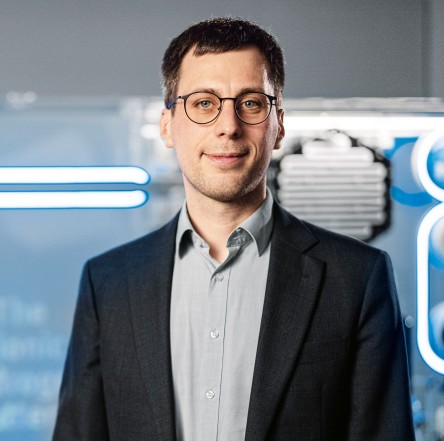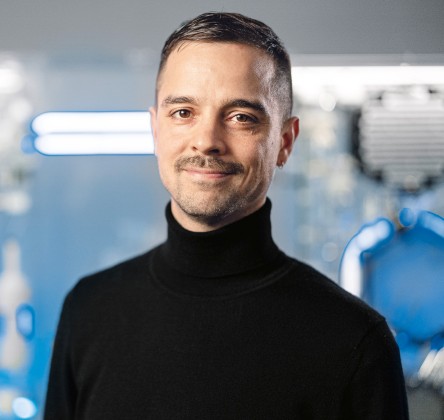
생물학적 과정의 핵심은 Thermoanaerobacter kivui(T. kivui) 박테리아입니다. 이 박테리아는 중앙 아프리카에서도 빛과 산소로부터 멀리 떨어진 키부 호수의 진흙 깊은 곳에 살고 있습니다. 이 박테리아는 자연적으로 수소(H2)와 이산화탄소(CO2)를 포름산(CH2O2)로 또는 그 반대로 변환할 수 있는 효소를 지니고 있습니다.
이러한 특성은 프랑크푸르트 괴테 대학교에서 "분자 미생물학 및 생물 에너지학" 학과장인 폴커 뮐러(Volker Müller) 교수가 이끄는 팀이 상세히 연구하였으며, Festo는 해당 프로젝트와 관련하여 긴밀히 협력하고 있습니다.
효율적인 저장
오늘날까지도, 수소 저장 및 운반은 여전히 까다로운 과제입니다. 일반적인 방법은 수소를 고압에서 압축하거나 극저온에서 액화 또는 화학적으로 전환하는 것입니다. 이 모든 프로세스는 에너지 집약적이며 복잡합니다.
T. kivui 박테리아를 이용하면 수소는 약 65°C의 온도와 1.5bar의 낮은 압력에서 포름산으로 전환될 수 있으며, 이는 상대적으로 적은 노력으로 저장 및 운반할 수 있습니다.
생물학적 과정이긴 하나, 이 반응은 세포의 성장과 관련이 없기 때문에 빠르게 이루어집니다. 오히려 박테리아는 촉매처럼 사용됩니다. 박테리아가 소모되어 사라지지 않으며 사이클에 따라 충분한 재생 단계를 통해 원하는 대로 프로세스를 반복할 수 있습니다.

"상온에서 T. kivui 박테리아의 성장이 멈춥니다. 이러한 조건에서 세포를 수년 동안 보관할 수 있으며 언제든지 재활성화할 수 있습니다. 이것은 유연하게 필요에 따른 사용 역시 가능하게 할 것입니다."
아드리안 아일링스펠트(Adrian Eilingsfeld) 박사, Festo의 바이오닉 프로젝트
복잡한 프로세스 자동화
이전까지 실험실에서만 가능했던 일을 이제 BionicHydrogenBattery를 통해 산업 규모로 달성할 수 있습니다. Festo 포트폴리오의 많은 제품은 매우 복잡한 생명공학 프로세스의 자동화를 보장합니다.
총 117종(1,089개 부품에 해당)의 다양한 Festo 제품 유형이 전시장에 설치되었습니다. 자동화 시스템 CPX-E와 결합된 새로운 모듈식 밸브 터미널 VTUX는 필요 공간이 적어 많은 수의 밸브를 제어합니다. Lifetech 포트폴리오의 매질 밸브 VYKC는 점성 바이오매스 용액을 바이오리액터 내부 및 외부로 원활하게 운반할 수 있도록 합니다. 필터를 통과하는 유량은 핀치 밸브 VZQA로 제어됩니다. 극도로 적은 양의 액체를 리액터에 정확하게 주입하기 위해 스텝 모터 EMMS-ST는 펌프 헤드와 연동 펌프로 작동합니다. 컬러 센서 SOEC는 초입자와 결합하여 극미량의 수소까지도 감지합니다.
안전한 프로세스
T. kivui 박테리아는 혐기성입니다. 즉, 산소가 없을 때만 번성합니다. 시스템에 누출이 발생하는 경우,박테리아는 즉시 죽게 되므로 인간에게 위험을 초래하지 않습니다. 동시에, 산소가 없으면 수소가 발화성 혼합물을 형성하는 것이 불가능해집니다. 더 나아가, 시스템에는 항상 아주 적은 양의 산소만이 포함되어 있습니다.
수소에서 포름산으로 – 그리고 그 반대로
수백만 년의 진화를 통해 박테리아는 대사 과정을 최적화했습니다. 우리는 그것들을 기술과 결합함으로써 박테리아의 능력을 활용할 수 있습니다. BionicHydrogenBattery를 사용하면 생물학적 과정을 소규모로 매핑할 수 있으며 Festo의 자동화 기술 덕분에 이제 원하는 대로 확장할 수 있습니다.
- 1: 바이오 리액터의 최적화된 조건 하에서 박테리아 T. kivui 증식.
- 2: 전기분해를 통해 물에서 수소를 생성.
- 3: 박테리아가 CO2를 변환하고 수소가 포름산으로 변함.
- 4: 산을 추출하여 용기에 담음.
- 5: 재전환을 위한 위치로 포름산을 안전하게 운반.
- 6: 동일한 박테리아가 포름산을 다시 분해하여 수소와 CO2로 변환.
- 7: 수소는 연료전지에서 다시 전기 에너지로 변환됨.
미래를 위한 지속 가능한 솔루션
생물학적 의미: 그래서 우리는 더 이상 자연으로부터 배우기만 하는 것이 아니라 자연과 협력합니다. 이로써, 우리는 미래의 세계를 위한 생태학적 혁신과 기후 친화적인 솔루션을 구현하고 현재와 미래 세대의 삶의 질을 향상시키는 데 기여합니다.
박테리아를 이용하여 에너지 효율적이고 위험을 낮춘 수소 저장은 큰 잠재력을 제공합니다. 이로써, 우리는 지속 가능한 방식으로 생성된 에너지가 충분할 때, 즉, 예를 들어 여름이나 바람과 햇빛이 충분한 국가에서 수소를 생산 및 저장할 수 있으며, 에너지 생산이 필요한 경우, 이를 다시 에너지로 회수할 수 있습니다.

"박테리아에 기술을 결합함으로써, 그 능력을 활용할 수 있습니다. 이로써 우리는 더 이상 자연으로부터 배우기만 하는 것이 아니라 자연과 함께 협력합니다."
제바스티안 슈로프(Sebastian Schrof), Festo의 바이오닉 프로젝트